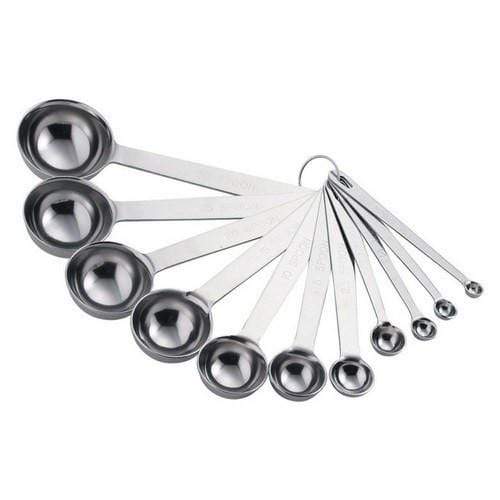We will show you how to use measuring spoons and cups in this article.
The products we used:
What are measuring spoons and cups used for?
Shaped like spoons, measuring spoons are commonly used to measure spices for seasoning.
They are perfect for measuring dry ingredients such as salt, sugar or pepper, for example. They can also be used for measuring liquid ingredients including soy sauce, vinegar or oyster sauce.
Measuring cups, on the other hand, are suited for measuring larger quantities of ingredients such as water, milk, bouillon broth, or Japanese Dashi soup stock.
They are also perfect for measuring flour when making bread or pizza.
Types of measuring spoons

Measuring spoons come in different sizes.
Each size corresponds to a certain amount. You can check the metric measurements below.
- 1/10spoon = 0.1ml
- 1/4spoon = 1.25ml
- 1/2spoon = 2.5ml
- 1spoon = 5.0ml
You might have seen in the list of ingredients, "1 teaspoon" or "1 tablespoon" in Japanese recipes. 1 teaspoon corresponds to 5 ml, and 1 tablespoon amounts to 15 ml. You can then calculate based on this measurement how much you should add each ingredient. If it says 1/2 teaspoon, you need to add 2 to 3 ml of ingredients. If it says 2 tablespoons, you will need to add 30 ml.
How to measure accurately with measuring spoons
Here are the instructions on how to use measuring spoons.
How to measure dry ingredients

When you measure dry ingredients such as salt, sugar or spices with measuring spoons, dip the spoon into the dry ingredient and level it off using a leveler or a bamboo food pick.
This extra step makes sure the measurement is accurate. You will be able to recreate the recipe and its taste.
How to measure liquid ingredients

If you are measuring liquid ingredients such as soy sauce, vinegar or sake, make sure to fill the spoons completely so that the liquid is little higher than the level due to surface tension.
If you want to measure liquids accurately, pour the ingredients on top of a plate so that they can spill without messing up with your measurement.
How to measure accurately using measuring cups

If you are measuring with measuring cups, pour the ingredients in the cup and check if they are level with the graduation on the cup from the side. Make sure to keep your face to the eye level with the cup for an accurate measurement.
If you are looking at it from above, your measurement will be incorrect.
When measuring dry ingredients such as flour, avoid packing the cup. Fill the cup with the ingredients without packing them and check if they are level with the graduation from the side.
Learn the basic cooking skill of accurate measurement!
Measuring the ingredients is the most important task in cooking.
If the measurement is incorrect, your food won't taste great even how amazing a recipe is.
We hope you now know the basic skill of measuring accurately with measuring spoons or cups.






